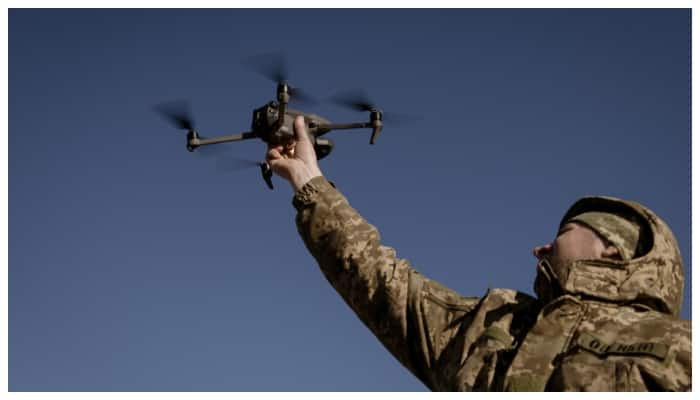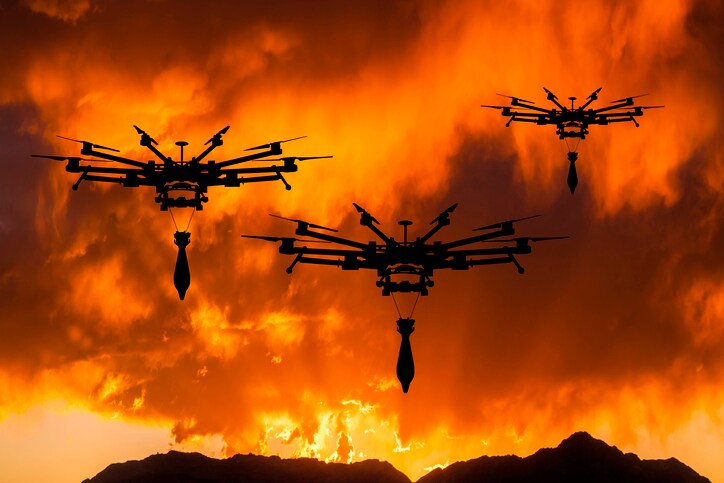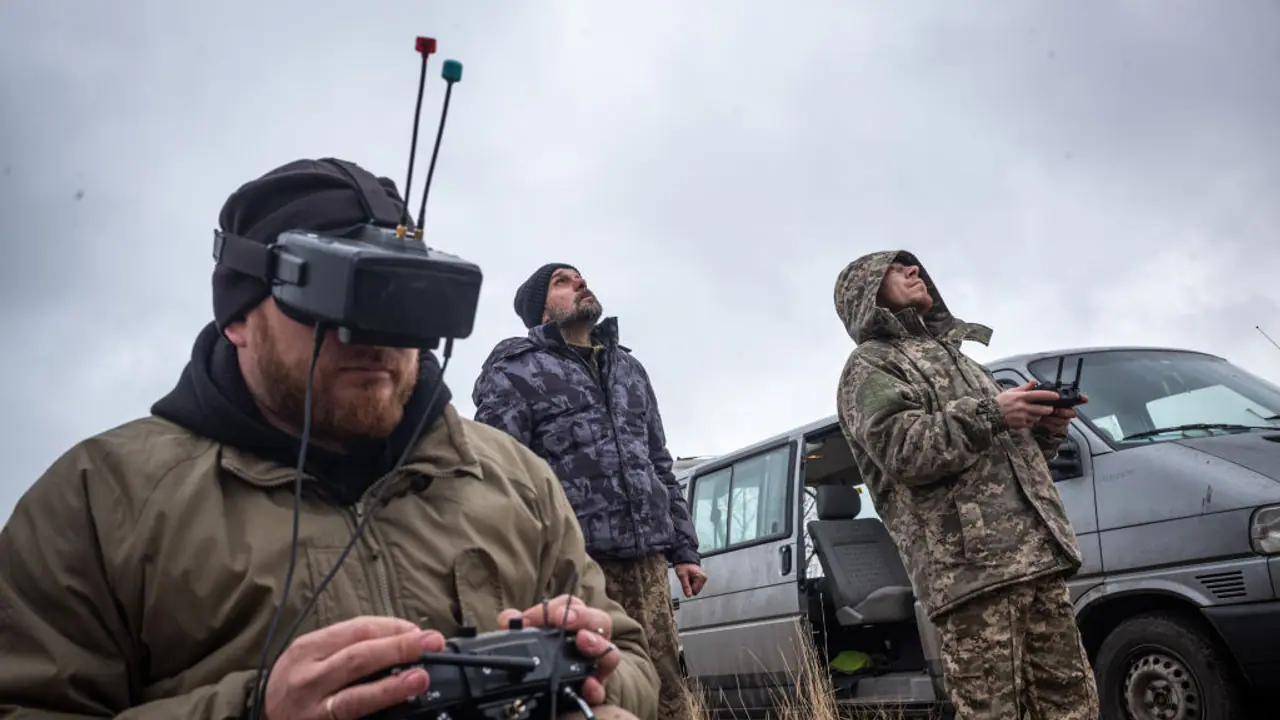AI-powered drones and loitering munitions are revolutionising modern warfare, transforming infantry tactics and precision strikes across global conflicts.
In December 2024, Ukrainian forces conducted an entirely unmanned ground assault on Russian positions using only First-Person View (FPV) drones and ground-based unmanned systems. This historic operation marked the first instance where a traditional infantry role was replaced by AI-powered drones, signalling a revolutionary shift in warfare. Simultaneously, during the Gaza conflict, the Israel Defense Forces (IDF) have been employing AI-guided loitering munitions to strike Hamas’ underground tunnel networks with pinpoint precision. This transformation is particularly significant for India, where the People’s Liberation Army (PLA) of China has been integrating AI-powered combat drones along the Line of Actual Control (LAC) to enhance their capabilities in high-altitude warfare. Recognising this challenge, India’s defence establishment is rapidly advancing its own drone warfare capabilities, including the development of state-of-the art swarm drone technology, AI-powered reconnaissance, and counter-drone systems. Glimpses of such technologies have been seen at the recent Republic Day Parade and the Army Day Parade.

The Evolution of Drone Warfare in Ground Combat
Drones, once considered auxiliary tools for surveillance and targeted strikes, have dramatically expanded their roles in recent conflicts. Advances in AI and Machine Learning (ML) are transforming drone capabilities by allowing them to operate with greater autonomy, while swarm drone tactics, where multiple drones coordinate to overwhelm enemy defences, have emerged as true game-changers. In addition, AI-assisted targeting systems now enable drones to identify, track, and engage enemy assets with minimal human intervention, fundamentally reshaping close combat strategies.
Also read: Indian Army's next leap: From advanced bulletproof jackets to exoskeleton technology
Case Study: Ukraine’s Drone Revolution
The ongoing Russia-Ukraine war has become a testing ground for AI-powered drone warfare. Ukrainian forces have effectively leveraged FPV drones and loitering munitions to strike Russian tanks, artillery, and logistical convoys with remarkable precision. For example, Ukrainian FPV drones have proven instrumental in targeting Russian T-90 tanks. In April 2024, one such drone struck a Russian T-90M by flying directly into its open hatch, resulting in a devastating explosion. In parallel, Russian forces have deployed Lancet-3 drones, which are equipped with AI-driven tracking systems, against Ukrainian air defences. Moreover, the integration of Electronic Warfare (EW) techniques, such as jamming technologies designed to disrupt enemy drones, has spurred a technological race between AI autonomy and counter-drone defences.

Swarm Drones & AI: Transforming Infantry Tactics
Swarm drones combined with AI and ML are fundamentally altering infantry warfare in several critical ways. First, advanced ML algorithms empower drones with AI-powered targeting and tactical awareness, enabling them to differentiate between military targets and civilian structures; this significantly reduces collateral damage. Ukraine’s effective use of AI-assisted reconnaissance drones has dramatically improved artillery accuracy and reduced the time required to acquire and engage targets. Second, the cost-effectiveness of these systems is striking: FPV drones, which can be acquired for as little as $500, have been used to destroy multi-million-dollar Russian tanks and armoured vehicles. Even non-state actors have capitalised on this technology; Hamas, for instance, has modified off-the-shelf DJI drones to carry explosive payloads. Third, the integration of unmanned systems into infantry operations is transforming the role of soldiers, who are now expected to operate these systems rather than serve solely as riflemen. The Indian Army, for example, is actively developing AI-assisted swarm drone systems tailored for high-altitude warfare.
Loitering Munitions: A New Era of Precision Strikes
Loitering munitions, often described as "suicide drones", are engineered to hover over a battlefield until they identify and execute precision strikes on high-value targets. In the context of the ongoing Israel-Hamas conflict, the IDF has been deploying AI-powered loitering munitions to effectively strike Hamas’ command centres and tunnel networks. These systems are programmed to autonomously track and engage moving targets, which enhances overall operational effectiveness.

Case Study: Israel’s Loitering Munition Doctrine
The adoption of AI-powered loitering munitions by the IDF represents a significant evolution in modern warfare tactics. These systems not only improve the accuracy of strikes but also minimise the need for prolonged human oversight in dangerous combat environments. Their ability to autonomously select and engage targets in complex terrains has set a new standard for military operations, demonstrating the potential of loitering munitions to be integrated into a broader, more effective combat strategy.
India’s Growing Loitering Munition Capabilities
India is making substantial progress in the indigenous development of loitering munitions, with several promising platforms currently under focus. Among these is DRDO’s suite of loitering munition systems designed for high-altitude precision strikes. Additionally, the collaboration between Adani and Elbit has resulted in the Mini Harop, a compact loitering munition that offers both surveillance and targeted attack capabilities. Furthermore, private sector companies such as Up and coming aerospace and defence start-ups are actively working on next-generation loitering munitions for the Indian Army, thereby reinforcing India’s expanding defence capabilities.
Strategic Implications for India
As battlefield technology evolves rapidly, India must prioritise the development of AI-driven drone warfare and robust counter-UAV capabilities. This strategic imperative involves several key elements. First, investing in indigenous AI-warfare development is critical to reduce dependency on foreign technologies by nurturing homegrown AI-powered drones and munitions. Second, India must bolster its counter-drone defences by investing in advanced electronic warfare (EW) systems and directed energy weapons (DEWs) designed to neutralise adversarial UAV threats. Third, there is a pressing need to adapt infantry training programs so that future soldiers are not only proficient in conventional warfare but are also skilled in drone operations, AI-assisted battlefield coordination, and networked combat operations. These strategic measures will ensure that India remains competitive and prepared for the evolving demands of modern warfare.
The transformative experiences in Ukraine and Gaza have unequivocally demonstrated that AI-powered drones and loitering munitions have evolved from auxiliary tools to central elements of modern combat. As infantry tactics undergo a fundamental transformation, nations that fail to adapt risk military obsolescence. For India, the future of warfare lies in the seamless integration of AI-powered systems to secure battlefield superiority. The challenge now is to strategically incorporate these advanced technologies while ensuring their responsible and ethical deployment. In this rapidly evolving combat environment, the infantryman of the future will not merely be a traditional soldier but will serve as a technologically adept battlefield commander operating within an AI-driven combat ecosystem.
(Ashu Maan is an Associate Fellow at the Centre for Land Warfare Studies. He is currently pursuing his PhD from Amity University, Noida, in Defence and Strategic Studies.)
